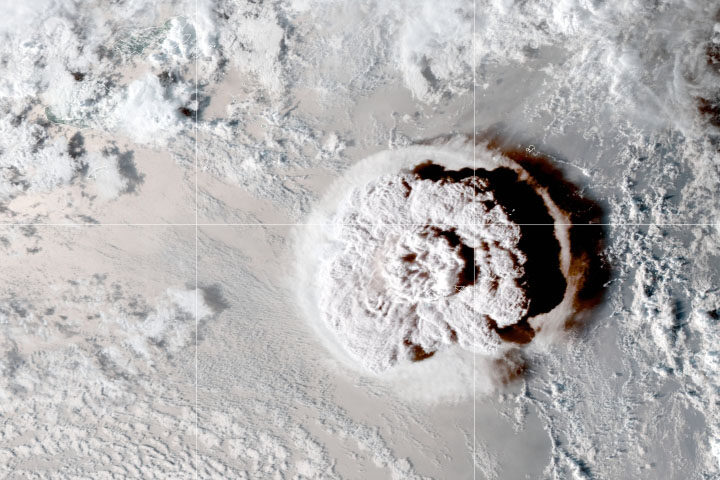
© NASA Earth ObservatoryHunga Tonga-Hunga Ha'apai erupts on 15 January 2022.
Undersea volcanic eruptions account for more than three-quarters of all volcanism on Earth, but
rarely do we see the impacts.
The
Hunga Tonga-Hunga Ha'apai eruption of 2022 was a
dramatic exception. Its furious explosion from shallow waters broke the ocean surface and punched
through the stratosphere, generating
supercharged lighting and an atmospheric shock wave that circled the globe
several times.
But there was far more to the fallout than satellite images could possibly capture or observers could report.
We know the human toll this explosion took, but now a new study investigating the underwater impacts of the Hunga-Tonga eruption has detailed just how ferociously the explosion tore open the seafloor, ripped up undersea cables, and smothered marine life.
"The eruption causes dramatic changes to nutrient and oxygen levels in the water which could have feedbacks that we are yet to understand," says first author Sarah Seabrook, a marine biogeochemist at the New Zealand National Institute of Water and Atmospheric Research.
Based in New Zealand, a country closely acquainted with undersea volcanoes, Seabrook and her colleagues compared seafloor mapping surveys conducted three months after the January 2022 eruption with data collected from the same area between 2015 and 2017.
"While ocean impacts resulting from volcanic eruptions are typically hidden from view," the researchers
write in their paper, "we show they can have major consequences, including widespread loss of marine life and damage to critical seafloor telecommunication links, with knock-on socioeconomic impacts."
The team also compiled a trove of data from ship-based sonar, sediment cores, geochemical analyses, water column samples, and video footage to chart the devastatingly powerful upheaval.
"No such data previously existed for an event on the scale of the 2022 Hunga volcano eruption," Seabrook and colleagues
write.
"Most submerged volcanoes are poorly mapped," they add, describing the underwater impacts of shallow-water volcanoes near populated islands as a "major blind spot" in risk assessment and preparedness.Their analyses show at least 6 cubic kilometers (km3) of seafloor was lost from within the caldera - 20 times the eruptive volume of the 1980 Mount St. Helens eruption - and an additional 3.5 km3 of material was blasted out of the Hunga volcano's submerged flanks.To put that in perspective,
previous studies of the Hunga Tonga-Hunga Ha'apai eruption estimated that 1.9 km
3 (or 2,900 megatonnes) of material was ejected into the atmosphere.
That leaves roughly four-fifths of the ejected material in the ocean; material that was funneled into fast-moving density flows that scoured out tracks 30 meters deep in the seafloor and accumulated 22 meters (72 feet) thick in some places.
Video footage showed much of the seafloor near the caldera was devoid of marine life or smothered in ashfall three months after the eruption.
But some wildlife refugia were discovered on nearby seamounts where the topography had protected animals from the outward blast. These refugia may aid the recovery of seafloor communities, although the researchers expect the recovery to be slow.
Very fine volcanic ash was found to be muddying the water column at depths of 200 meters (655 feet) up to 20 kilometers from the caldera. If those plumes persist, it could have as-yet unknown impacts on food security for Pacific Island nations.
"Future monitoring, of both the volcanic edifice itself and the surrounding seafloor and habitats, is necessary to robustly determine the resilience and recovery of both human and natural systems to major submarine eruptions,"
says Seabrook.
"It will also help more broadly assess the risks posed by the many similar submerged volcanoes that exist worldwide."
In 2012, scientists
nearly missed the largest deep-ocean eruption in recorded history.
The blast erupted out of the previously little-known Havre Seamount in the Kermadec Islands that arc northward of New Zealand towards Tonga.
At least we've got our eye on these two now, but
there are an estimated 100,000 uncharted undersea volcanoes still out there in the abyss.The study has been published in
Nature Communications.
[Link]
Check out the second photo, showing the plume covering much of the Earth...